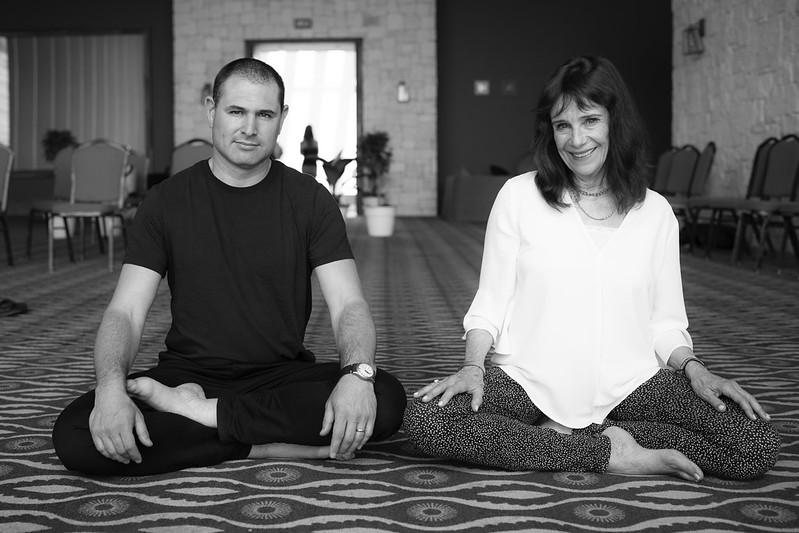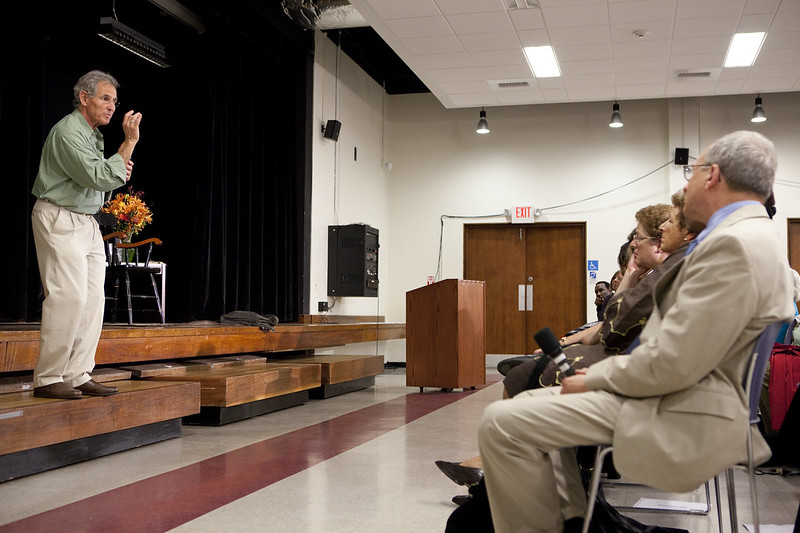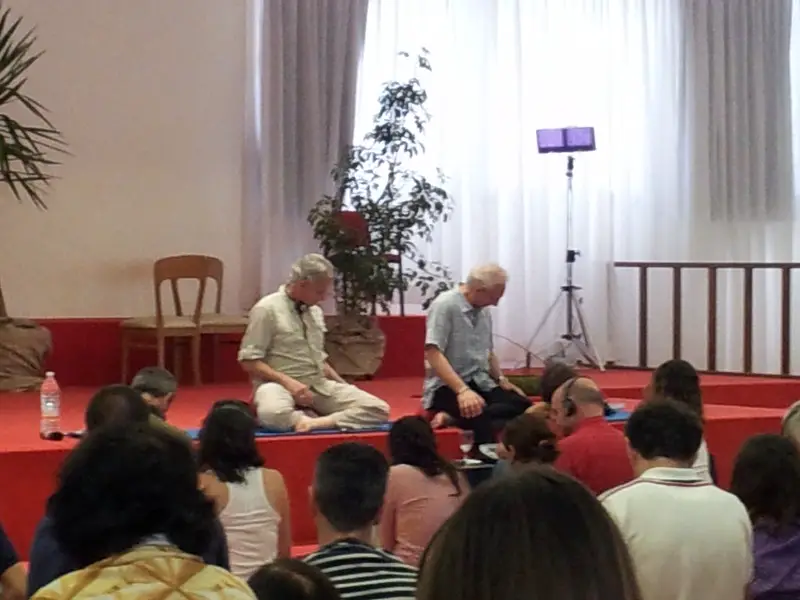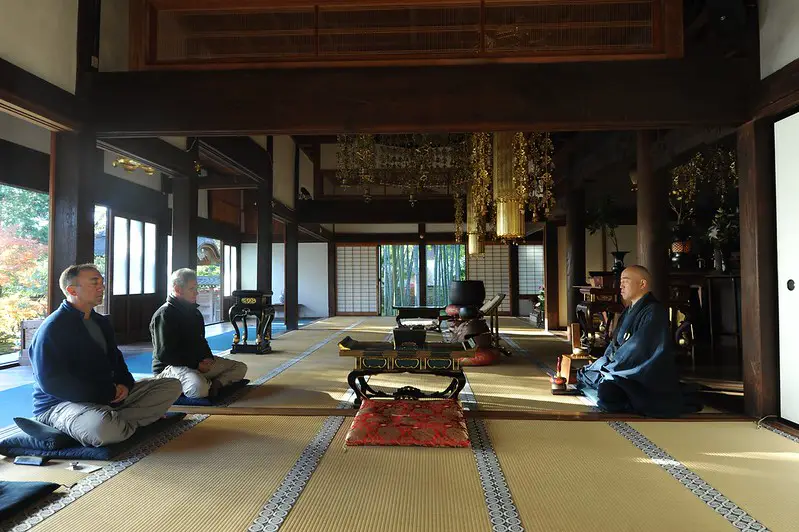In the movie Zorba the Greek, there is a line in which Zorba, who is a happy leading character, defines his life as “the full catastrophe!” Zorba is not a pessimistic person. It is even the opposite of that. He implies the fact that a rich life consists of great pleasures and disasters, as well as small happiness and minor irritations. And without isolating yourself from the joys of life, you cannot isolate yourself from the discomfort and disasters of life.
If you face the disasters of your life, the joys of your life will increase. It sounds pretty easy, right? However, as you learn from painful experiences, it is not all that simple to confront sadness, stresses, regrets, and misfortunes.
Fortunately, there is a way to improve the open, calm acceptance of stress, sadness, and pain. It offers useful coping strategies for pain through awareness, a meditation technique that connects the mind and body, and intensifies pleasures.

Chapter 1 – Awareness sheds light on you so that you can be in the present moment.
Just imagine the moments you will experience. How do you spend this valuable time? Perhaps you will feel the slight wind coming to your face for the last time or you will enjoy taking a bite from your food for the last time or you will hear the melody of the sounds coming from your window for the last time.
When you think this way, you realize that you have moments to live. Because a whole life consists of successive moments.
To get the most out of life, you have to spend every moment in the best way. Awareness can show you how.
A question may come to your mind: Is it something I should learn to experience the present moment? Can’t I experience this because I’m already in it?
You can try it now. Try to stay only at this moment.
How long does it take for a thought to take you away from now? If you are like other people, it won’t be long at all. Although our bodies are present now, our minds will crawl in the future or the past as they get used to it. And this is not good at all. In fact, according to a study conducted at Harvard in 2012, we feel calmer, more determined, and happier when our mind focuses on the present rather than the future or past.

Right here, awareness comes into play. This is a meditation technique focused on giving mental attention and physical sensation in the present moment. Working on awareness helps us fix our complex thoughts and feel all the texture of today. Moreover, through awareness meditation, we establish a deeper connection with our bodies, recognizing and learning to deal with early warning signs of depression, stress, and anger.
Now I give you a simple awareness exercise to try. Take three raisins in your hand. Examine the first raisins thoroughly. What does this raisin look like? How does it smell? How do you feel it on your fingers? Then put raisins in your mouth and start chewing: How does it taste? How does it feel in your tongue and teeth?
Eat the other two raisins in the same way. Every time, try to deepen your focus on the process of eating raisins. And with this deeper focus, the sensory experience of eating raisins will increase each time.
Like eating raisins – slowing down to fully focus on even the most ordinary situations is the first step towards a mindful life.
Chapter 2 – Meditation calms the mind and gives awareness to stay in the moment.
Now I’ll tell you something familiar. You spend your days with “doing” something: work, silly tasks, responsibilities, commitments. But at the end of the day, when your body stops doing something, your mind will still work. It reviews the events of the day, plans for the future, scan for concerns, and more.
Awareness creates space for “being” in a life full of “doing”. But you cannot “be” with a mind that just “doing” something. So how can you calm a busy mind?
So how do you need to meditate? In short, you try to “be” instead of “doing”.
It is easier to say than do, of course, but let’s take a step and start our first exercise.
Start by providing physical comfort. A sitting position is ideal, especially for beginners. Make your back straight and take care to keep your back aligned with your neck and head. Relax your shoulders and put your hands in a comfortable place, such as on your lap or your knees.

Then slowly focus on your breathing. Just record the feelings of your breath. Feel the air tickling in your nostrils while breathing. Feel the expansion of your lungs. Observe the feeling of freshness and replenishment in your body after each breath.
Finally, go back to your thoughts. Your goal is your mind that is still working. However, this does not mean that you have to stop your mind completely. Instead, let your thoughts go through your mind. Confirm and leave every incoming thought. As an observer, try to give equal time to every thought, whether about death or buying cat food. The longer you stay alone with your thoughts, you will easily understand that these are just these: thoughts. These don’t identify you. They don’t create your reality. These are only incoming and passing thoughts.
At first, you may have trouble meditating for a long time. Your constantly working mind may come into play or your body may be uncomfortable. If these occur, please do not give up. Instead, understand what distracts you, then turn your mind back to silence. This can repeat hundreds of times in minutes, but that’s fine.
If you are comfortable sitting, breathing, and letting your thoughts go through the mind, you have fully grasped the basics of meditation.
Chapter 3 – To reach awareness naturally, you should improve your meditation practice.
When was the last time you noticed the steamy heat of the morning shower, the unexpected beauty of your layout with the pencil, or the sketch was drawn by the shadows on a sunny sidewalk?
Once you are fully aware, you will see that you create spontaneously aware moments like these throughout the day. You will naturally calm down, take care, and be fully present in the moment.
However, it is necessary to practice to come to this level. Assume awareness as a muscle, and meditation as a muscle-building training. The more you do the meditation exercise, the more spontaneous awareness moments you will experience.
Awareness is to develop a strong mind-body connection. That’s why a basic meditation technique consists of body-scan meditation. How to do this is explained below.
First, leaning on your back. As you do in sitting meditation, try to focus on your breathing. Let your thoughts go through your mind without thinking about them. If you are ready to begin body-scanning, give your full focus to the toes on your left foot.
This is done the way you do while focusing on your breath. Gather your concentration in your left toes and let your thoughts go through you. Be aware of the sensations you have on each toe – even if these sensations are perceived as numbness or discomfort.
Evaluate these feelings with awareness without judgment: think they are neither good nor bad. They just exist. Finally, try whether you can direct your breath to your left toes.

Now when you pause for a few breaths in your left toes, slowly pull your focus up to your leg. Continue repeating this process slowly and intentionally for each part of your body.
After applying the body scanning technique, it’s time to direct your awareness of different emotions in your body. For example, you may feel anger in your pit, fear at your fingertips, or calm on your shoulders.
Just as you direct your breath to your left toes, try to direct different energies such as kindness, healing, or strength to your body areas that need them.
If you regularly practice body scan meditation, you are programmed to be – that is, to be in your body and to be present. If you use this time to “be” instead of “to do”, you will develop stagnation, calmness, and mental stability.
Chapter 4 – We cannot control stress factors, but we can check the responses we give them.
Stress is like the weather, right? Stress is something we can’t predict or control. And like a sudden rainstorm when it suddenly begins to rain on us, it is impossible to escape from stress or stand under it.
Stress, like weather, is like an uncontrollable force that shapes our lives. However, unlike the weather, we have more control over stress than we noticed. We should consider stress as a two-factor condition: a stressor and a response. Stressors are the conditions or situations that cause stress, and the responses are the emotions and behaviors created by stressors within us. Stress happens to us. However, we produce responses to stress ourselves.
Stressors and changes are outside our control area. We can control our stress responses. But most of the time, we act like we cannot.
When we encounter short-term acute stress factors- for example, a bus we missed- we tend to respond with adrenaline. We feel disappointment and even anger. When we are faced with chronic long-term stress factors such as ongoing financial problems, we get lost in feelings of melancholy and depression.
None of these reactions is great. But these emotions get worse. Our bodies and minds seek ways to deal with negative emotions, rather than facing the stress factors that cause these reactions. We take these deeply rooted coping strategies in the autopilot so we never have to deal with the main source of our stress.

These coping strategies can often become much more harmful than the stress factors they want to remove. These negative dealing methods are called maladaptive coping strategies.
Some of these incompatible coping strategies can be denial, workaholics, alcohol or drug addiction, eating disorders, or shopping addiction. When we attach to unusually bad coping strategies, we enter a vicious circle in which our responses turn into stress.
Fortunately, it is possible to disrupt this vicious circle as described in the following chapter.
Chapter 5 – Instead of reacting to stress, you can improve yourself to respond to stress.
You remember the Choose Your Own Adventure books, right? When the narrative becomes the most important part of the books, you are asked to choose what will happen next. Open the third page to reach the dragon’s lair from the shortcut. Open the seventh page to go the long way in the forest.
Our way of responding to stress can appear instinctively, but we have a “choose your own adventure” element: we always have an option. Are you arguing with your spouse? You can leave the house with anger. You can break it up by throwing a plate on the wall. You can talk about it. You can stay cold and quiet. Or you can try to see things from other points of view.
Performing mindfulness exercises provides time and space to consider all possible responses to a stress factor.
Imagine making a mistake at work, for example. What is your usual sudden reaction? Do you accuse your boss of giving you this job? Do you criticize yourself intimately? Do you want to work overtime like a workaholic for the rest of the week? None of these reactions are good for you – autopilot reactions to stress are rarely are.
Awareness allows you to exit the autopilot state. Thus, instead of reacting to the stress factor mindlessly, you begin to recognize it as aware.
Next time when you make a mistake in your work, focus your awareness on what is happening in this situation. Try to stay in the moment and record what your physical reactions are. Your palms may be sweating. Your heart may be beating fast. Accept these reactions without judgment. These reactions are not good or bad. These are just the sensations you’re having right now. Try to do the same for your emotional reactions. Feel your emotions without raising them.

Then, address stress and put it in context without preventing or reflecting your reaction to stress. Why did you make this mistake? What will be the consequences of this mistake? What can you learn from this mistake? How can you give the best answer to this mistake?
You break the reaction cycle of stress by sitting and waiting. You are experiencing a pause that allows you to examine your response to stress.
Aware of your response to stress, of course, does not change the reality of your mistake. This does not reduce the stress you are experiencing. But it prevents your reactions to stress from increasing your stress even more.
Chapter 6 – Awareness allows us to live with pain and even get support from pain.
Life would be better for you in every way if you didn’t feel physical pain, right?
This may not always be true. Have you heard of congenital analgesia? People with this condition cannot just feel physical pain. They cannot understand that they hurt themselves because they cannot feel the pain. Without pain, which is a warning against danger, it is quite difficult for these people to move around the world safely.
Pain is a tutor. It teaches us how far our borders can reach and how we can protect ourselves from dangers. There is a lot to learn from pain, but when we have to deal with chronic pain, it becomes difficult to understand the lesson we will learn.
There’s nothing positive about suffering. Pain and especially chronic pain can be weakening, costly, and psychologically destructive. But even if you cannot change the fact that you are suffering, you can at least manage this situation with awareness.
Make a good sense of the term “manage”.With awareness, you cannot eliminate pain. This is not like turning a lamp on or off. Instead, it’s something that can be controlled.
We believe that pain is felt completely physically. Pain occurs in three dimensions. The sensory dimension- a state of the physical sensation of pain. The emotional dimension- a state of feeling about pain. The cognitive dimension- a state of thought about pain. We can use awareness to relieve pain in all three dimensions. How to do it will be explained below.

Practice a body scan meditation exercise to detect the pain. Sit on a nice mat. After finding the pain, ask it to stay for a while. Record every sensation – there may be a sharp bump or dull pain.
Get your attention to the present moment. How bad is your pain? Too unbearable? Or do you expect it to become unbearable? The truth is that your pain is likely to be tolerated now and will continue to be that way for a while. Accept your pain without guessing and realize how easy it is to manage.
With your attention still on the aching area of your body, try to discover the emotional and cognitive dimensions of your pain. Describe your thoughts and feelings about pain. Accept these feelings and thoughts and let them pass. Your thoughts about your pain are not painful. Your feelings about your pain are not painful.
Chapter 7 – Awareness can open the doors of happiness by alleviating emotional pain.
Do you think you are a really happy person? If you answer “no”, there is no judgment. It’s really hard to feel happy. We all live with grief and trauma. We were all injured.
But give it a try: focus on the moment and your present. Silence your thoughts. Be in your body and mind. Are you feeling happy now? You can understand that you are happy right now.
For example, you think you do not feel happy. What keeps you from being happy? The reason is probably patterns of thought arising from past emotional pain. For example, you may think that you do not deserve to be loved due to a bad break-up that you have experienced in the past. These sneaky patterns of thought may be your answer to pain, but they also prevent you from facing the pain. These settled patterns cause you to escape, reject, or reflect your pain. As a result, they only increase your pain.

The next time you feel emotional pain, address this pain with soft awareness. First, focus your attention on emotional experience. Do you feel anger? Sadness? Dull pain? Realize how these emotions grow and flow. Emotional pain is temporary. It is constantly changing. If you stay long enough with these emotions, you can understand that they have a starting and ending point. Emotional pain does not persist. It won’t last forever.
Treat in the same way for the incoming thoughts and images in your mind because of your feelings. Go through every thought without judging or imposing any meaning on them. Don’t make predictions or get stuck in the past. Realize how these thoughts and images transform. Notice that there are a start and an endpoint. These thoughts are not permanent either.
Finally, question your thoughts and feelings. Get your attention at the moment. Ask yourself, “Am I happy now and not letting myself see this happiness?”
If you answer “no” to these questions, ask yourself again “What can I do to eliminate this unhappiness?”
Staying aware of painful emotions and thoughts will show you that they are just emotions and thoughts. These feelings and thoughts don’t have you. Thinking this way is the first way to let them go.
Of course, everything should not be allowed to go, if possible, it should be changed. The next section will explain how to use awareness to understand which option will continue.
Chapter 8 – Increase your awareness to accept your feelings and solve your problems.
You have probably heard of the serenity prayer. It starts with “Give me peace of mind to accept what I cannot change, and give me the power to change the things I can.”
But how can we understand the things can be changed and cannot be changed? It is useless and futile to try to change things that cannot be changed. It is equally bad to accept things that can be changed.
There is a method that shows what can be changed and what should be left. Awareness can help you notice the difference.
Your emotional pain has two different aspects – your emotions and troubles. Imagine going for a nature trekking. The weather got worse and you’re stuck on a steep hill. Your path has become slippery due to the rain. This situation is quite frightening. You are dealing with both a sense of fear and a problem – how will you continue your walk?
When you are faced with emotional pain, use your awareness to separate it into a feeling and a problem.
Stay with emotion first. Let it pass through you like a stunning wave. DonDon’t judge about these emotions. Examine them tenderly. Then question what this feeling is trying to teach you. Is the source of your pain fear? Maybe this teaches that you need to be careful. Is this considered guilt? Perhaps this feeling is poking you to change something.

Then, stay alone with your problems separated from your emotions. Ask yourself this: What can I do to smooth this problem? Does a solution proposal come up? Wonderful! Does the problem seem too difficult for a single solution? Try to divide the problem into smaller pieces. Maybe there is no obvious solution? Then don’t do anything. But do it on purpose. Since this choice is the most efficient way, let this problem go without addressing it.
Let’s go back to the person trapped on the slippery walking path. The main point is not to let your emotions interfere with your problems. Don’t let the feeling of fear send you back downhill without finding a safer walking path. Do not allow fear endanger you and put you at risk of injury.
Be aware of your emotions and then face your problems. Improve your awareness to live the moment, you will soon find yourself on more solid ground.
Full Catastrophe Living: Using the Wisdom of Your Body and Mind to Face Stress, Pain, and Illness by Jon Kabat-Zinn Book Review
It is impossible to imagine a life without pain, sadness, and unfortunate. Ironically, trying to get rid of the negative aspects of life can deprive you of the happiness of life. While disasters occur beyond your control, you can control how you respond to them. Use awareness meditation to enjoy the moments and overcome troubles.
Improve your loving-kindness meditation.
Are you clinging to a pain experienced in the past? You may need some healing. Start meditating in a seated position. Then guide loving-kindness towards you inward. Then direct loving-kindness outward, first to someone you care about, then to someone you feel neutral. Finally, if you think it is possible, direct the same energy to the person or situation that hurts you.
